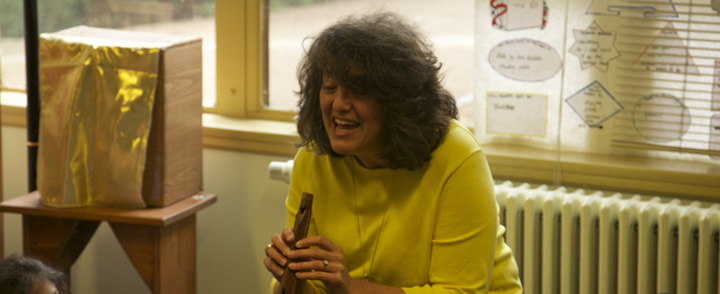Emily K. Alhadeff Associate Editor
This story complements the JTNews’ new podcast, “A Freilechen Seattle,” available here or at the iTunes store. Subscribe to The Transcript podcast on iTunes.
Jeffrey Grossman’s retirement dream was to learn Yiddish.
“As I got older, I can’t tell you what it was, it lit that spark in me,” he said.
But there was one problem. When Grossman, who spent his life in New York where there are plenty of opportunities to learn and speak Yiddish, retired, he ended up relocating to Issaquah to be near his grandchildren.
“I looked around to see if there was anybody teaching Yiddish and I couldn’t find anybody,” he said. “I was very disappointed.”
On a whim, he contacted Temple Beth Am, where he had heard they were teaching Hebrew. It just so happens that Temple Beth Am’s music director, Wendy Marcus, is a Yiddish maven.
“I said ‘Jeffrey, I am so busy, I’m swamped, I would love to teach but I can’t do this,’” Marcus recalled. “He said, ‘I’ll just come over and we’ll talk.’”
One conversation turned into another, which led to a small group, which led to Marcus launch a beginning Yiddish class last October. Beginners and more advanced speakers emerged, creating the need for two levels, and scheduling conflicts created a need for classes on weekdays as well as Sundays at Temple Beth Am. Native Yiddish speaker Ayn Dalgoff came onboard to teach the intermediate class. The mailing list bloomed to about 40 Yiddish enthusiasts.
“Seattleites tend to come to things a little bit more slowly, but once they’re there they’re committed,” said Marcus. “Some people want to learn because they’re nostalgic. Some people want to teach it to their kids. Other people are just fascinated with the language because it’s such a jargon…. Some people are just language nudniks.”
If the presence of Yiddish enthusiasm in Seattle can be traced to a source, it is Ruth Peizer, who learned Yiddish from her Latvian immigrant parents. She taught classes and promoted Yiddish in Seattle with what Marcus calls “a missionary zeal.” Marcus was one of Peizer’s disciples.
Peizer died last October, and her children are in the process of going through her extensive Yiddish library. A portion of her books went to the Yiddish Book Center in Amherst, Mass., and a portion went to Marcus, who is using them in her classes.
Marcus’s and Dalgoff’s students cross the age spectrum. Most interesting is the generation of young adults fueling a Yiddish and Klezmer revival. One of Marcus’s students, Eli Davis, is a 21-year-old who spent last summer on the Yiddish Farm, a sustainable farming-Yiddish immersion program in New York.
“Right now we have this Jewish generation that’s seeking their language,” said Marcus.
Marcus pointed out the irony: Two of the strongest groups keeping Yiddish going are young, culturally but not necessarily religiously affiliated Jews, and Orthodox, Hassidic Jews, who speak Yiddish at home.
“I’m not willing to say Yiddish is dying,” she said, “because there are these two camps.”
And as Isaac Bashevis Singer would say, quotes Marcus: “It’s not a dead language; it’s a dying language. And for us Jews, there’s a long time between dying and death.”
Indeed, death is a long way off for Yiddish, especially now that it’s found a renovated home in Seattle, thanks to Grossman’s persistence.
“My being a catalyst was a total fluke thing,” said Grossman. “Sometimes good things happen by accident.”
It sounds like a Yiddish phrase, doesn’t it? “Gut mazel iz min-hashamayim!” — good fortune comes from heaven.
